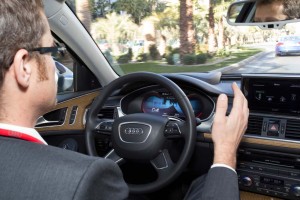The Massachusetts Institute of Technology publication “Technology Review” is sending kudos to Audi by naming the German maker as one of its “50 Most Disruptive Companies” for Audi’s ongoing hands-off driving project.
Audi unveiled the so-called “Piloted Driving” system at the Consumer Electronics Show in Las Vegas earlier this year and the system basically is an extension of the company’s adaptive cruise control and lane-keeping assist features.
Audi noted at the time the “Piloted Driving” car, an A6 wagon, was designed to aid drivers caught in heavy traffic and could be ready for sale within a decade. The traffic-jam assist system previewed at CES does not feature fully autonomous driving. Audi leaves the driver in charge of the vehicle since the system only works in sub-40-mph situations on highways.
The technology used on the piloted driving project is based on Audi’s adaptive cruise control with stop and go function, and is enhanced by a lateral guidance system. Two radar sensors monitor an area up to 820 feet ahead of the vehicle at a 35-degree scanning angle. A wide-angle video camera monitors the lane markings and can also detect objects such as other vehicles, pedestrians and guardrails.
Eight ultrasonic sensors monitor the zones directly in front of the car and at its corners. There is also a laser scanner that supplies high-precision data gathered at an angle of about 140 degrees and as far as 260 feet ahead of the car.
In the words of Audi Board of Management Chairman Rupert Stadler: “We are greatly honored to be included in the group of the world’s most innovative companies. It shows that Audi is well equipped for the future.”
A variety of automakers and suppliers have been experimenting with different versions of autonomous driving, even tech giant Google, which has clocked tens of thousands of miles with its prototypes. Some proponents insist the technology could be ready for market before the end of the decade. Audi is taking a more cautious role, limiting its system to relatively low speeds in moderate to dense traffic where it’s easy for a motorist to become distracted and wind up experiencing a fender-bender.
The Audi Piloted Driving system senses when traffic is moving along quicker than about 40 mph, or isn’t very dense, and automatically cuts out, Audi officials note.
The maker’s technical chief Wolfgang Durheimer, contends the concept “is a logical step for Audi.” Not only does it make use of existing vehicle systems but it fits the Volkswagen subsidiary’s slogan, “Vorsprung durch Technik,” which translates into “moving forward through technology.
Each year, MIT and Technology Review look for companies all over the world that have unveiled potentially groundbreaking technologies. A “disruptive company” is a business whose innovations force other companies to alter their strategic course.
“As a group, the companies on this list represent our best judgment of the commercial innovations most likely to change lives around the world,” according to the Technology Review’s editors.
Inclusion in the MIT list of “50 Disruptive Companies” is the third award gained by Audi’s Piloted Driving technology. In January, Popular Science magazine named it a “Product of the Future”, and the specialized media network “The Verge” named the new Audi system “Best Automotive Technology” at the Consumer Electronics Show.


Audi’s handless driving is a nice idea but there will be big problems when people crash while texting or talking on their cellphone as they will claim the car was driving, not them. It’s goning to be the same with hands-free parking.